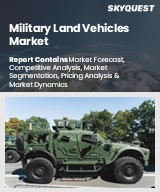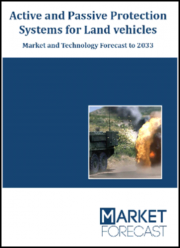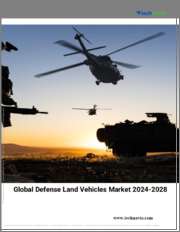
|
시장보고서
상품코드
1747468
세계의 군용 육상 차량 시장 평가 : 차량 유형별, 기동성별, 기술별, 지역별 - 기회 및 예측(2018-2032년)Global Military Land Vehicles Market Assessment, By Vehicle Type, By Mobility, By Technology, By Region, Opportunities and Forecast, 2018-2032F |
||||||
세계 군용 육상 차량 시장 규모는 2024년 265억 2,000만 달러에서 2032년 368억 5,000만 달러에 달할 것으로 예상되며, 2025-2032년의 예측 기간 동안 연평균 4.20% 성장할 것으로 예측됩니다. 세계 각국은 혁신적인 군용 차량 구매를 통해 군사력을 강화하고 있으며, 이는 세계 군용 육상 차량 시장의 확대를 주도하고 있습니다. 국방비가 증가하고 각국 정부가 국방 예산에 더 많은 자금을 할당함에 따라 국제 시장에서 군용 육상 차량에 대한 수요가 증가함에 따라 군용 육상 차량 시장이 확대될 것입니다. 군용 육상 차량은 첨단 기술을 요구하는데, 이는 현대 전쟁이 첨단 방어 시스템을 필요로 하는 첨단 작전 스타일로 계속 진화하고 있기 때문입니다. 군는 끊임없는 기술 발전과 혁신적인 기술 기능의 출현을 통해 정교한 육상 차량의 개발을 실현하고 있습니다.
군용 육상 차량은 보병 전투 차량, 장갑차, 장갑차, 주전차, 소형 다용도 차량, 전술 트럭 등 다양한 역할을 수행합니다. 각 유형의 차량은 특정 방어 용도에 맞게 조정되어 상대적으로 향상된 군사 능력을 제공합니다. 군사 현대화, 지정학적 긴장, 군사 작전은 국방 용도에 필요한 지속적인 지출을 의미합니다. 군용 차량의 전기화는 시장에서 증가하는 추세 중 하나입니다. 이 기술은 연료 사용 감소, 배기가스 배출 감소, 운영 안정성 향상 등 여러 가지 이점을 제공합니다. 전 세계 군용 육상 차량 제조업체는 세계 국방 요구 사항과 병행하여 보안, 적응성 및 기술 진화에 대한 전략적 집중을 유지하고 있습니다. 군의 지속적인 작전 강화 추구는 전략적 목표 달성과 함께 첨단 기술이 탑재된 차세대 육상 차량에 대한 지속적인 투자를 촉진하고 향후 많은 차량 반복을 위한 지속 가능한 시장을 창출할 것입니다.
예를 들어, 2025년 1월 영국에서 생산된 초기 Boxer 장갑차가 International Armored Vehicles(IAV) Conference에서 공식적으로 발표되었습니다. Programme에 따라 영국 텔포드에 위치한 Rheinmetall BAE Systems Land(RBSL)에서 생산되고 있습니다.
세계의 군용 육상 차량 시장에 대해 조사 분석했으며, 시장 규모와 예측, 시장 역학, 주요 기업 개요 등의 정보를 전해드립니다.
목차
제1장 프로젝트의 범위와 정의
제2장 조사 방법
제3장 미국 관세의 영향
제4장 주요 요약
제5장 고객의 소리
- 응답자 인구통계
- 브랜드 인지도
- 구입 결정에서 고려되는 요소
- 멀티 미션 롤에의 적응성
- 전투 지대에서의 내구성
제6장 세계의 군용 육상 차량 시장 전망(2018년-2032년)
- 시장 유형 분석과 예측
- 금액
- 시장 점유율 분석과 예측
- 차량 유형별
- 장갑 전투차 양
- 전술 차량
- 병참차량
- 기동성 별
- 차륜
- 무한 궤도
- 수륙 병용
- 기술별
- 전기/하이브리드
- 내연기관
- 자율 시스템
- 지역별
- 북미
- 유럽
- 아시아태평양
- 남미
- 중동 및 아프리카
- 시장 점유율 분석 : 기업별(주요 5개사와 기타)(금액)(2024년)
- 차량 유형별
- 시장 맵 분석(2024년)
- 차량 유형별
- 기동성 별
- 기술별
- 지역별
제7장 북미 군용 육상 차량 시장 전망(2018년-2032년)
- 시장 유형 분석과 예측
- 금액
- 시장 점유율 분석과 예측
- 차량 유형별
- 장갑 전투차 양
- 전술 차량
- 병참차량
- 기동성 별
- 차륜
- 무한 궤도
- 수륙 병용
- 기술별
- 전기/하이브리드
- 내연기관
- 자율 시스템
- 점유율 : 국가별
- 미국
- 캐나다
- 멕시코
- 차량 유형별
- 각국 시장 평가
- 미국 군용 육상 차량 시장 전망(2018년-2032년)
- 시장 유형 분석과 예측
- 시장 점유율 분석과 예측
- 캐나다
- 멕시코
- 미국 군용 육상 차량 시장 전망(2018년-2032년)
제8장 유럽 군용 육상 차량 시장 전망(2018년-2032년)
- 독일
- 프랑스
- 이탈리아
- 영국
- 러시아
- 네덜란드
- 스페인
- 튀르키예
- 폴란드
제9장 아시아태평양 군용 육상 차량 시장 전망(2018년-2032년)
- 인도
- 중국
- 일본
- 호주
- 베트남
- 한국
- 인도네시아
- 필리핀
제10장 남미 군용 육상 차량 시장 전망(2018년-2032년)
- 브라질
- 아르헨티나
제11장 중동 및 아프리카 군용 육상 차량 시장 전망(2018년-2032년)
- 사우디아라비아
- 아랍에미리트(UAE)
- 남아프리카공화국
제12장 Porter의 Five Forces 분석
제13장 PESTLE 분석
제14장 시장 역학
- 시장 성장 촉진요인
- 시장이 해결해야 할 과제
제15장 시장 동향과 발전
제16장 사례 연구
제17장 경쟁 구도
- 시장 리더 주요 5개사의 경쟁 매트릭스
- 주요 5개사의 SWOT 분석
- 주요 기업 10개사 상황
- Oshkosh Corporation
- BAE Systems plc
- Rheinmetall AG
- KNDS N.V.
- IND Defense LLC
- Thales Group
- Singapore Technologies Engineering Ltd
- Patria Group
- General Dynamics Corporation
- JSC Research and Production Corporation URALVAGONZAVOD
제18장 전략적 제안
제19장 회사 소개 및 면책조항
LSH 25.06.24Global military land vehicles are projected to witness a CAGR of 4.20% during the forecast period 2025-2032, growing from USD 26.52 billion in 2024 to USD 36.85 billion in 2032. Countries from all over the world strengthen their military power through the purchase of innovative military vehicles to drive the expansion of the global military land vehicle market. The military land vehicle market expands because defense spending increases and governments allocate more funds to their defense budgets which generates a higher need for military land vehicles in international markets. Military land vehicles demand advanced technology because contemporary warfare continues to evolve toward more advanced operational styles that need sophisticated defense systems. The military achieves the development of sophisticated land vehicles through continuous technological advancements and the appearance of innovative technical features.
Military land vehicles fulfill various roles such as infantry fighting vehicles, armored personnel carriers, main battle tanks, light multi-role vehicles, and tactical trucks. Each type of vehicle is tailored to its specific defense applications and provides a relatively improved military capability. Military modernizations, geopolitical tensions, and military operations represent necessary ongoing spending for defense applications. Military vehicle electrification is a rising trend in the market. Technology brings multiple benefits to the table, such as lower fuel usage, reduced emissions and better operational stability. Military land vehicle manufacturers worldwide maintain their strategic focus on security, adaptability, and technological evolution alongside global defense requirements. The ongoing pursuit of operational enhancements by military units, together with strategic goal achievement, drives continuous investments toward next-generation land vehicles equipped with advanced technology, thus creating a sustainable market for multiple future vehicle iterations.
For instance, in January 2025, the initial Boxer armored vehicle manufactured in the United Kingdom was formally unveiled at the International Armored Vehicles (IAV) Conference. The Boxer vehicle has been produced at Rheinmetall BAE Systems Land (RBSL) in Telford under the U.K.'s Mechanized Infantry Vehicle (MIV) Programme.
Increasing Geopolitical Tensions Drive the Military Land Vehicle Market
Rising geopolitical pressures lead countries to hike defense spending. With additional investment, military services can acquire new ground vehicles, replace old equipment, and enhance readiness against potential threats. Geopolitical pressures can propel nations to grow in their military modernization program and procurements. Modernizing extends to all forms of land vehicle fleets, replacing legacy equipment with modern platforms that will take advantage of new mobility, protection, firepower, and communication capabilities. Geopolitical pressures that exist between great powers and strategic competitors can accelerate efforts to develop and field new technology, including land vehicles. Competition between great powers and strategic adversaries can create pressure, promote innovation, and lead to the creation of next-generation vehicles that are supposed to create, maintain, or gain competitive advantage.
For instance, in October 2024, Russia's KamAZ opened a production plant in Senegal to manufacture both military trucks and MRAP (Mine-Resistant Ambush Protected) vehicles, including the Typhoon-K, marking a major step in Russia-Senegal defense and industrial cooperation.
Technological Advancements in Military Land Vehicles
The rise in technological innovations is another major force fueling the military land vehicles market. The introduction of advanced technologies such as artificial intelligence, unmanned platforms, and better communication systems in military vehicles is transforming the face of defense operations. The inclusion of electric and hybrid military vehicles is also prominent, keeping in view sustainable military practices to minimize carbon footprints. This technological development not only improves combat capability but also cuts defense budget costs, thus being a driving force for the military land vehicles market growth. The use of lightweight composite materials in vehicles enables manufacturers to build protective systems with improved mobility features which maintain durability as advanced military vehicles emerge through sensor technology and artificial intelligence in the military environment.
For instance, in April 2025, the Taiwanese Army unveiled an upgraded version of the M1167 Humvee, with improved armor, bulletproof glass, and an advanced TOW anti-tank-guided missile system with day-and-night targeting. All these upgrades should enhance survivability, firepower, and mobility, while also increasing Taiwan's anti-armor capability at a time when regional security threats are on the rise.
Armored Vehicles Dominate the Military Land Vehicles Market
Armored vehicles continue to be at the forefront of military land vehicles. The rising global security threats have led numerous countries to dedicate substantial financial resources and military assets toward developing armored platforms for troop protection and operational dominance. Contemporary armored vehicles combine advanced technological elements through their design which includes reactive armor and composite armor as well as active protection systems and integrated digital communication systems to enhance their battlefield capabilities. Most modern platforms incorporate modular designs, and many of these systems have the capability or potential for rapid upgrades and mission-specific configurations. There is certainly a strong trend towards better mobility and firepower, as well as a need for subjecting the increase in crew protection, and with governments committing to modernize and grow their fleets, it is suitable that the modernization of the armored vehicle segment will only continue to grow.
For instance, in May 2025, Rheinmetall and Indra Group signed a strategic cooperation agreement to work on armored solutions for the Spanish Armed Forces (FAS). With Rheinmetall's proficiency in vehicle manufacturing and Indra's proficiency in defense electronics, the two companies aim to assist the FAS in advancing its armored fleet while increasing European defense capabilities.
North America Dominates the Military Land Vehicle Market
The massive defense spender globally is the United States, which is a key contributor to the North American military land vehicles industry. Its defense budget funds the procurement, development, and maintenance of a varied fleet of ground vehicles for different military branches. North American military firms are significant players in the international arms market, selling military land vehicles to allies and partners. The US Foreign Military Sales (FMS) program permits the export of defense equipment, mostly land vehicles, to established foreign governments, thus supporting market growth. North American defense corporations are increasingly turning their attention towards cybersecurity and information warfare capabilities to defend military networks, command systems, and communication platforms incorporated into land vehicles.
The Asia-Pacific region confronts numerous security threats, which involve territorial conflicts, together with local disputes and emerging asymmetrical dangers. Governmental organizations in the area allocate financial resources to develop military equipment, particularly land vehicles, to enhance their defense capabilities and protect national safety. The Asia-Pacific area has seen a rising number of local defense manufacturers who develop land vehicle technologies for the military sector. South Korea, together with India and Singapore, operates its national armored vehicle production systems that enhance regional independence while expanding export possibilities. The rising economic development, together with infrastructure expansion across Asia-Pacific, enables military land vehicles to operate in various operational settings, including urban zones and remote regions, and maritime zones.
For instance, in May 2024, Textron Systems Corporation and Kodiak Robotics Inc. partnered to develop a military ground vehicle for fully driverless operations. By integrating Kodiak's autonomous "Kodiak Driver" technology and Defense Pods sensor suites into Textron's vehicle platform, the collaboration aims to deliver advanced, uncrewed vehicles for high-risk military missions and logistics support.
Impact of U.S. Tariffs on Military Land Vehicles Market
Tariffs on steel, aluminum, and vehicle parts are high costs for manufacturing armored and tactical vehicles.
Companies are switching to United States-made components to escape tariffs, impacting sourcing strategies and schedules.
Defense contractors face delays and higher prices for imported components, prompting supply chain re-evaluation.
Increased costs could strain military budgets or push out procurement programs, particularly for large vehicle fleets.
Tariffs are pushing the industry to invest in domestic manufacturing, potentially encouraging innovation but requiring upfront investment.
Key Players Landscape and Outlook
The global market for military land vehicles faces substantial rivalry between multiple leading international producers that drive advancements in the defense sector technology. Multiple market leaders maintain extensive product ranges that feature armored personnel carriers, infantry fighting vehicles, main battle tanks, and specialized tactical vehicles. The industry's most prominent organizations commit substantial resources to research and development for producing forward-thinking mobile vehicles that match contemporary military needs. Businesses in this industry use strategic partnerships along with merger and acquisition activities to enhance their technological expertise and worldwide market presence.
For instance, in January 2025, Rheinmetall and Leonardo received regulatory approval to form Leonardo Rheinmetall Military Vehicles (LRMV), a joint venture based in Rome. LRMV will develop and market advanced military vehicles, including a new Italian main battle tank based on the Panther KF51 and the Lynx platform for the Armored Infantry Combat System programme.
Table of Contents
1. Project Scope and Definitions
2. Research Methodology
3. Impact of U.S. Tariffs
4. Executive Summary
5. Voice of Customers
- 5.1. Respondent Demographics
- 5.2. Brand Awareness
- 5.3. Factors Considered in Purchase Decisions
- 5.4. Adaptability to Multi-Mission Roles
- 5.5. Durability in Combat Zones
6. Global Military Land Vehicles Market Outlook, 2018-2032F
- 6.1. Market Type Analysis & Forecast
- 6.1.1. By Value
- 6.2. Market Share Analysis & Forecast
- 6.2.1. By Vehicle Type
- 6.2.1.1. Armored Fighting Vehicles
- 6.2.1.2. Tactical Vehicles
- 6.2.1.3. Logistical Vehicles
- 6.2.2. By Mobility
- 6.2.2.1. Wheeled
- 6.2.2.2. Tracked
- 6.2.2.3. Amphibious
- 6.2.3. By Technology
- 6.2.3.1. Electric/Hybrid
- 6.2.3.2. Internal Combustion Engine
- 6.2.3.3. Autonomous Systems
- 6.2.4. By Region
- 6.2.4.1. North America
- 6.2.4.2. Europe
- 6.2.4.3. Asia-Pacific
- 6.2.4.4. South America
- 6.2.4.5. Middle East and Africa
- 6.2.5. By Company Market Share Analysis (Top 5 Companies and Others - By Value, 2024)
- 6.2.1. By Vehicle Type
- 6.3. Market Map Analysis, 2024
- 6.3.1. By Vehicle Type
- 6.3.2. By Mobility
- 6.3.3. By Technology
- 6.3.4. By Region
7. North America Military Land Vehicles Market Outlook, 2018-2032F
- 7.1. Market Type Analysis & Forecast
- 7.1.1. By Value
- 7.2. Market Share Analysis & Forecast
- 7.2.1. By Vehicle Type
- 7.2.1.1. Armored Fighting Vehicles
- 7.2.1.2. Tactical Vehicles
- 7.2.1.3. Logistical Vehicles
- 7.2.2. By Mobility
- 7.2.2.1. Wheeled
- 7.2.2.2. Tracked
- 7.2.2.3. Amphibious
- 7.2.3. By Technology
- 7.2.3.1. Electric/Hybrid
- 7.2.3.2. Internal Combustion Engine
- 7.2.3.3. Autonomous Systems
- 7.2.4. By Country Share
- 7.2.4.1. United States
- 7.2.4.2. Canada
- 7.2.4.3. Mexico
- 7.2.1. By Vehicle Type
- 7.3. Country Market Assessment
- 7.3.1. United States Military Land Vehicles Market Outlook, 2018-2032F*
- 7.3.1.1. Market Type Analysis & Forecast
- 7.3.1.1.1. By Value
- 7.3.1.2. Market Share Analysis & Forecast
- 7.3.1.2.1. By Vehicle Type
- 7.3.1.2.1.1. Armored Fighting Vehicles
- 7.3.1.2.1.2. Tactical Vehicles
- 7.3.1.2.1.3. Logistical Vehicles
- 7.3.1.2.2. By Mobility
- 7.3.1.2.2.1. Wheeled
- 7.3.1.2.2.2. Tracked
- 7.3.1.2.2.3. Amphibious
- 7.3.1.2.3. By Technology
- 7.3.1.2.3.1. Electric/Hybrid
- 7.3.1.2.3.2. Internal Combustion Engine
- 7.3.1.2.3.3. Autonomous Systems
- 7.3.1.2.1. By Vehicle Type
- 7.3.1.1. Market Type Analysis & Forecast
- 7.3.2. Canada
- 7.3.3. Mexico
- 7.3.1. United States Military Land Vehicles Market Outlook, 2018-2032F*
All segments will be provided for all regions and countries covered
8. Europe Military Land Vehicles Market Outlook, 2018-2032F
- 8.1. Germany
- 8.2. France
- 8.3. Italy
- 8.4. United Kingdom
- 8.5. Russia
- 8.6. Netherlands
- 8.7. Spain
- 8.8. Turkey
- 8.9. Poland
9. Asia-Pacific Military Land Vehicles Market Outlook, 2018-2032F
- 9.1. India
- 9.2. China
- 9.3. Japan
- 9.4. Australia
- 9.5. Vietnam
- 9.6. South Korea
- 9.7. Indonesia
- 9.8. Philippines
10. South America Military Land Vehicles Market Outlook, 2018-2032F
- 10.1. Brazil
- 10.2. Argentina
11. Middle East and Africa Military Land Vehicles Market Outlook, 2018-2032F
- 11.1. Saudi Arabia
- 11.2. UAE
- 11.3. South Africa
12. Porter's Five Forces Analysis
13. PESTLE Analysis
14. Market Dynamics
- 14.1. Market Drivers
- 14.2. Market Challenges
15. Market Trends and Developments
16. Case Studies
17. Competitive Landscape
- 17.1. Competition Matrix of Top 5 Market Leaders
- 17.2. SWOT Analysis for Top 5 Players
- 17.3. Key Players Landscape for Top 10 Market Players
- 17.3.1. Oshkosh Corporation
- 17.3.1.1. Company Details
- 17.3.1.2. Key Management Personnel
- 17.3.1.3. Key Products Offered
- 17.3.1.4. Key Financials (As Reported)
- 17.3.1.5. Key Market Focus and Geographical Presence
- 17.3.1.6. Recent Developments/Collaborations/Partnerships/Mergers and Acquisitions
- 17.3.2. BAE Systems plc
- 17.3.3. Rheinmetall AG
- 17.3.4. KNDS N.V.
- 17.3.5. IND Defense LLC
- 17.3.6. Thales Group
- 17.3.7. Singapore Technologies Engineering Ltd
- 17.3.8. Patria Group
- 17.3.9. General Dynamics Corporation
- 17.3.10. JSC Research and Production Corporation URALVAGONZAVOD
- 17.3.1. Oshkosh Corporation
Companies mentioned above DO NOT hold any order as per market share and can be changed as per information available during research work.



















